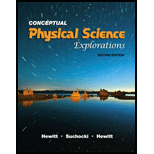
Use the bond energies in Table 20.1 and the accounting format shown in Section 20.3 to determine whether these reactions are exothermic or endothermic:
(a)
(b)
Whether the given reactions are exothermic or endothermic.
Answer to Problem 1TS
The given reactions are exothermic reactions.
Explanation of Solution
(a) The given reaction,
There is one
There is one
Thus, the total energy absorbed to break the bonds in the reactant is
There are two
Thus, the net energy of the reaction can be given as,
Thus, it is an exothermic reaction.
(b) The given reaction,
There is one
There are five oxygen molecules having
There are two
Also, there are two
Thus, the total energy released to make the bonds in the product is
Thus, the net energy of the reaction can be given as,
Thus, it is an exothermic reaction.
Conclusion:
Therefore, the given reactions are exothermic reactions.
Chapter 20 Solutions
Conceptual Physical Science Explorations
Additional Science Textbook Solutions
Essential University Physics: Volume 1 (3rd Edition)
The Cosmic Perspective
Physics: Principles with Applications
College Physics: A Strategic Approach (4th Edition)
Conceptual Integrated Science
Sears And Zemansky's University Physics With Modern Physics
 College PhysicsPhysicsISBN:9781305952300Author:Raymond A. Serway, Chris VuillePublisher:Cengage Learning
College PhysicsPhysicsISBN:9781305952300Author:Raymond A. Serway, Chris VuillePublisher:Cengage Learning University Physics (14th Edition)PhysicsISBN:9780133969290Author:Hugh D. Young, Roger A. FreedmanPublisher:PEARSON
University Physics (14th Edition)PhysicsISBN:9780133969290Author:Hugh D. Young, Roger A. FreedmanPublisher:PEARSON Introduction To Quantum MechanicsPhysicsISBN:9781107189638Author:Griffiths, David J., Schroeter, Darrell F.Publisher:Cambridge University Press
Introduction To Quantum MechanicsPhysicsISBN:9781107189638Author:Griffiths, David J., Schroeter, Darrell F.Publisher:Cambridge University Press Physics for Scientists and EngineersPhysicsISBN:9781337553278Author:Raymond A. Serway, John W. JewettPublisher:Cengage Learning
Physics for Scientists and EngineersPhysicsISBN:9781337553278Author:Raymond A. Serway, John W. JewettPublisher:Cengage Learning Lecture- Tutorials for Introductory AstronomyPhysicsISBN:9780321820464Author:Edward E. Prather, Tim P. Slater, Jeff P. Adams, Gina BrissendenPublisher:Addison-Wesley
Lecture- Tutorials for Introductory AstronomyPhysicsISBN:9780321820464Author:Edward E. Prather, Tim P. Slater, Jeff P. Adams, Gina BrissendenPublisher:Addison-Wesley College Physics: A Strategic Approach (4th Editio...PhysicsISBN:9780134609034Author:Randall D. Knight (Professor Emeritus), Brian Jones, Stuart FieldPublisher:PEARSON
College Physics: A Strategic Approach (4th Editio...PhysicsISBN:9780134609034Author:Randall D. Knight (Professor Emeritus), Brian Jones, Stuart FieldPublisher:PEARSON





